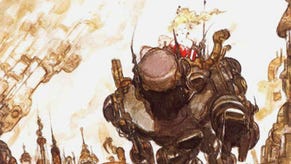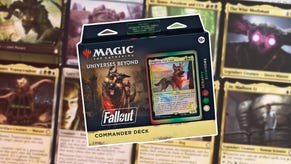Daily Classic: Curse of the Azure Bonds, the Alternate Universe Final Fantasy XIII
Ever wondered what Final Fantasy XIII might have been like as a PC RPG? 25 years ago, SSI answered that question preemptively.
This article first appeared on USgamer, a partner publication of VG247. Some content, such as this article, has been migrated to VG247 for posterity after USgamer's closure - but it has not been edited or further vetted by the VG247 team.
Stop me if you've already heard this one: A ragtag group of adventurers finds itself drawn together when they're inexplicably cursed with mysterious markings by unknown parties.
These mystical marks render the adventurers subject to the will of those beings, forced to act against their desires, and the afflicted warriors seek to break free of their unwanted geas. The path they take, and the actions they're forced to perform, put them at odds with the law. The six heroes become outcasts, pariahs, outlaws, struggling against powerful forces to regain their own agency and become once again the masters of their own destiny.
This may seem like an outline of the plot for Final Fantasy XIII, but in truth I've been describing a game that debuted 20 years before FFXIII made its debut (and in fact before the original Final Fantasy even made its way to America). 1989's Curse of the Azure Bonds presented players with an adventure whose plot bears remarkable similarities in the abstract to FFXIII, but in truth the two games couldn't be less alike. And not just on a technological level.
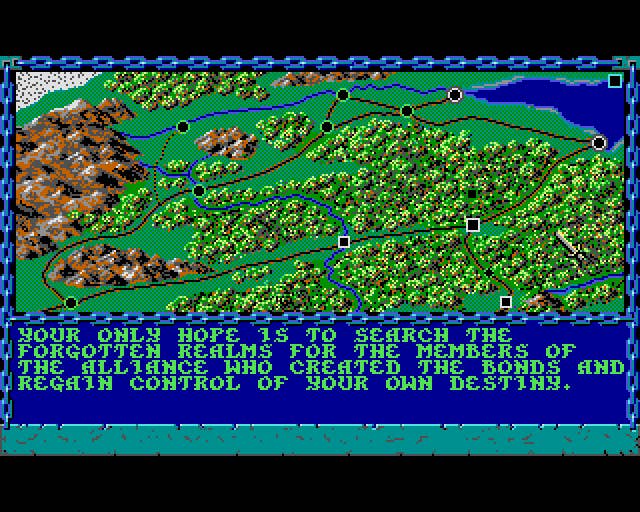
The commonalities between last generation's much-hyped installment of Final Fantasy and Azure Bonds — whose title refers for the five mysterious markings that afflict the player's party members — ultimately serve to throw the evolutionary differences between Japanese and Western RPG design philosophies into sharp relief. Of course, I'm speaking in generalities, here; there is no hard demarcation between RPGs of different origins, and you can easily name a dozen exceptions to any rules you want to lay down concerning the genre. Japanese games like Dark Souls and Shin Megami Tensei IV have more in common with "Western" RPGs than with something like Tales of Xillia, and Kickstarter is lousy with Western-designed RPGs conspicuously patterned after "JRPGs" like Phantasy Star and Final Fantasy.
But generally speaking, Japanese role-playing games kicked off in earnest with Dragon Quest, which was equal parts Wizardry and graphical adventure — combat-driven, yes, but also a bit more linear, more compact, and more concretely story-driven than Western RPGs of the era. Because most Japanese gamers and designers alike discovered RPGs through Wizardry and The Black Onyx rather than through playing Dungeons & Dragons, the drive to remain faithful to the genre's pen-and-paper roots was never quite as strong. When Phantasy Star II and Final Fantasy IV came along to introduce manga and theatre influences to the format, Japanese RPGs never (well, rarely, anyway) looked back.
In the U.S., of course, Dungeons & Dragons became a powerful cultural force in the '80s. Parents and preachers hated it, but that just made it all the more attractive to teens. Unsurprisingly, RPGs designed in the Americas throughout the '80s and '90s remained ever faithful to D&D's core concepts: Its classes, its lore, its skills, its rules.
No RPGs better channeled the spirit of D&D than Strategic Simulations Inc.'s "Gold Box" games of the late '80s... appropriately so, given that they were licensed adaptations of TSR's actual Advanced Dungeons & Dragons license. While that may sound like a no-brainer (of course the AD&D games were true to AD&D!), the mere presence of the D&D license was by no means a guarantee of a quality video game. While few if any official D&D video releases of the '80s had been truly bad, none managed to adapt the experience in a truly satisfying way until SSI created the Gold Box titles — a series that included Curse of the Azure Bonds.
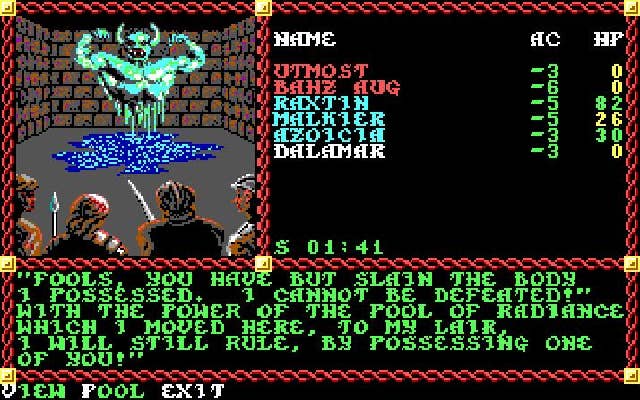
In fact, Azure Bonds had close ties to its Gold Box contemporaries. It was meant to be an expansion of the blockbuster Pool of Radiance and allowed players to carry over their party from the previous adventure. The Wizardry games had pioneered the concepts of retaining a party throughout a multi-part series, though Azure Bonds went about it in a far friendlier manner to newcomers; whereas Wizardry sequel players who had failed to complete a previous chapter of the series were basically out of luck, those just getting into the Gold Box titles without having compatible cross-compatible titles Pools or Hillsfar simply began the adventure with a massive pool of experience to divide among their party members, enough even to allow for multi-classing.
Much of Azure Bonds remained the same as it had been in Pools of Radiance. Exploration played out through a rudimentary first-person perspective similar to that of many earlier RPGs, but combat took place in a more tactical overhead view, like Ultima but better. Players could face massive enemy parties, but by drawing on proper D&D lore they could overcome those nasty odds and triumph as well. Behind the scenes, players could roll up just about any party combination they could imagine, drawing on the full scope of D&D races and classes, the full alignment grid, and even choosing different genders as well.
Where the game really stood apart from Japanese and console RPGs, however, was in its sense of openness. The party must track down the forces behind the five different azure bonds that afflict them, and after severing the mandatory first bond the whole world opens up to allow the party to seek and destroy their other four mysterious antagonists. Far from being a linear experience, Azure Bonds grants a profound sense of freedom of choice at every turn, from party composition to the order of events in the heat of action.
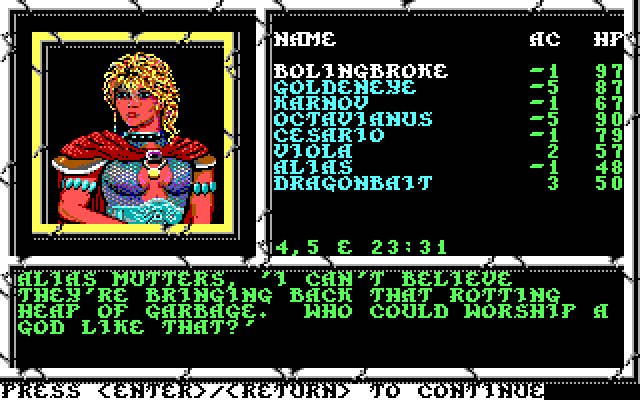
One way in which Azure Bonds wasn't so dissimilar to FFXIII: While the core game replayed plenty of plot, much of the world-building depended on supplemental materials. FFXIII had its built-in database, while Azure Bonds leaned heavily on D&D manuals, expansions, and even novels. Of course, one might say that was the entire point of a game like this. It was meant to offer an interactive adaptation of a richly realized universe, an expression of AD&D concepts and lore in a compact, self-contained wrapper.
Curse of Azure Bonds makes an interesting study in contrasts not only for modern takes on the RPG, but also against its own console-based contemporaries. Within a a few months of Azure Bonds, Japanese RPG fans were enjoying the likes of Phantasy Star II, Dragon Quest IV, Megami Tensei II, and Final Fantasy III — all excellent games, and all clearly connected to the same fundamental mechanical concepts on which Azure Bonds was built. Yet in those games you can see the Japanese concept of RPGs beginning to diverge more and more from the classical rules of D&D as their creators began to explore alternate approaches to storytelling and combat... and those standalone franchises began to iterate on their own distinctive elements, too.
In a way, the divergence of Japanese RPG from Azure Bonds and AD&D at this point would be imitated by Western RPGs a few decades later. About 10 years after Azure Bonds' debut, BioWare created Baldur's Gate, and Black Isle Studios used that tech to design Planescape Torment: Perhaps the two definitive video game renditions of the D&D concept. But in time, the D&D licensed passed into other hands, and BioWare began to push its role-playing concepts further and further away from AD&D fundamentals until we ended up with Mass Effect 3, a hybrid of shooter and role-playing game that bears little resemblance to the likes of SSI's Gold Box games.
But then, things have a way of coming full circle. All these years later, much of the talent at SSI has rebanded as TSI (Tactical Simulations Inc.) and is looking to revisit the Gold Box style of game, albeit seemingly without the D&D license. Who knows if Seven Dragon Saga will be regarded as fondly as classics like Curse of the Azure Bonds, but everyone who remembers the glory days of the Gold Box series is surely champing at the bit to find out.







